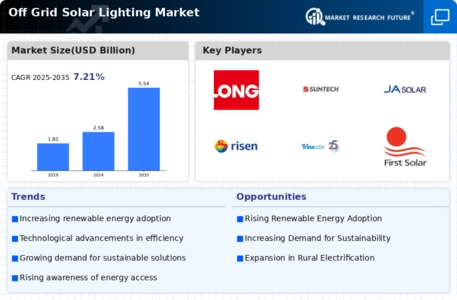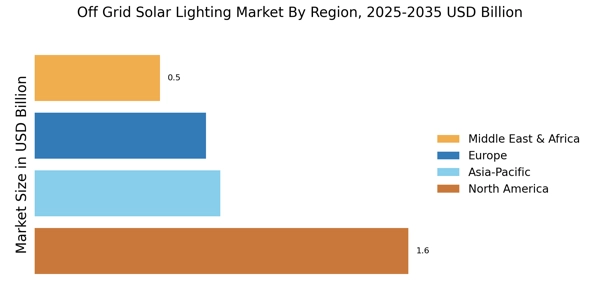Technological Innovations
Technological innovations play a pivotal role in shaping the Off Grid Solar Lighting Market. Advances in solar technology, such as improved battery storage systems and energy-efficient LED lighting, have enhanced the performance and reliability of off-grid solar solutions. These innovations not only increase the efficiency of solar lighting systems but also extend their lifespan, making them more appealing to consumers. Furthermore, the integration of smart technologies, such as mobile applications for monitoring energy usage, is expected to enhance user experience and engagement. As these technologies continue to evolve, they are likely to attract more investments and drive the expansion of the Off Grid Solar Lighting Market, catering to a growing demand for sustainable and efficient energy solutions.
Supportive Policy Frameworks
Supportive policy frameworks are crucial for the growth of the Off Grid Solar Lighting Market. Many governments are implementing policies and regulations that promote the adoption of renewable energy technologies, including off-grid solar lighting solutions. Incentives such as tax breaks, subsidies, and grants are being offered to encourage investments in solar energy. For example, some countries have established feed-in tariffs that guarantee fixed payments for solar energy producers, thereby enhancing the financial viability of solar projects. These supportive measures are likely to create a conducive environment for the Off Grid Solar Lighting Market, fostering innovation and attracting new players to the market, ultimately leading to increased access to solar lighting solutions.
Rural Electrification Initiatives
The Off Grid Solar Lighting Market is experiencing a surge due to various rural electrification initiatives. Governments and non-governmental organizations are increasingly focusing on providing electricity to remote areas where traditional grid connections are either unavailable or economically unfeasible. For instance, initiatives aimed at enhancing energy access in rural communities have led to a notable increase in the adoption of solar lighting solutions. Reports indicate that approximately 1.2 billion people lack access to electricity, creating a substantial market opportunity for off-grid solar lighting solutions. This growing demand is likely to drive innovation and investment in the Off Grid Solar Lighting Market, as stakeholders seek to develop cost-effective and efficient solar technologies to meet the needs of underserved populations.
Cost-Effectiveness of Solar Solutions
The Off Grid Solar Lighting Market is significantly influenced by the cost-effectiveness of solar lighting solutions. As the prices of solar panels and associated technologies continue to decline, the affordability of off-grid solar lighting systems becomes increasingly attractive to consumers. Recent data suggests that the cost of solar photovoltaic systems has decreased by over 80% in the last decade, making solar lighting a viable alternative to conventional energy sources. This trend is particularly relevant in regions where electricity costs are high or where grid access is limited. The economic advantages of solar lighting solutions are likely to propel the growth of the Off Grid Solar Lighting Market, as more households and businesses opt for sustainable energy solutions that offer long-term savings.
Environmental Sustainability Concerns
The Off Grid Solar Lighting Market is increasingly driven by growing concerns regarding environmental sustainability. As awareness of climate change and its impacts rises, consumers and businesses are seeking cleaner energy alternatives. Off-grid solar lighting solutions offer a sustainable way to illuminate homes and public spaces without contributing to greenhouse gas emissions. The shift towards renewable energy sources is not only a response to environmental challenges but also aligns with global efforts to achieve sustainable development goals. This heightened focus on sustainability is likely to bolster the Off Grid Solar Lighting Market, as more stakeholders recognize the importance of adopting eco-friendly energy solutions that minimize environmental footprints.


















Leave a Comment